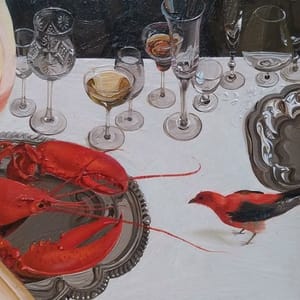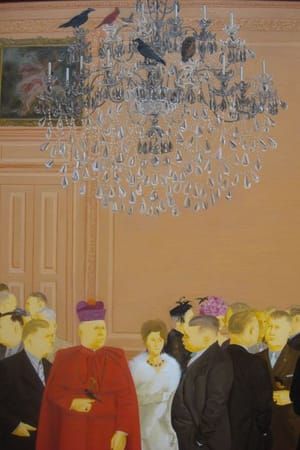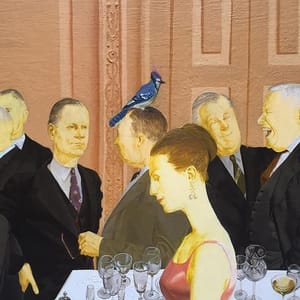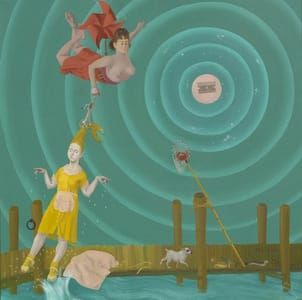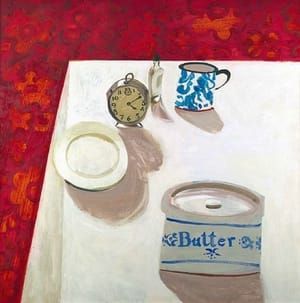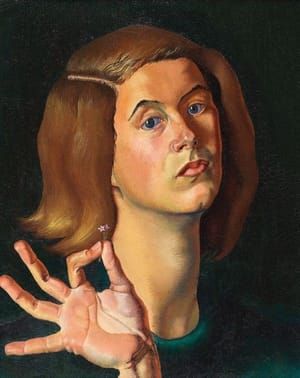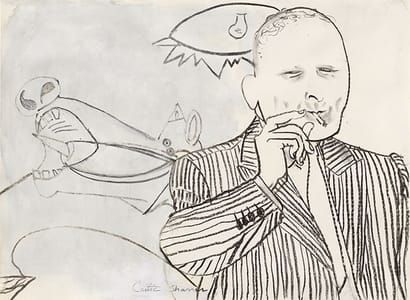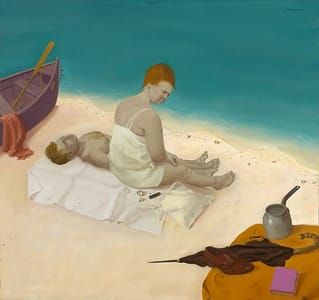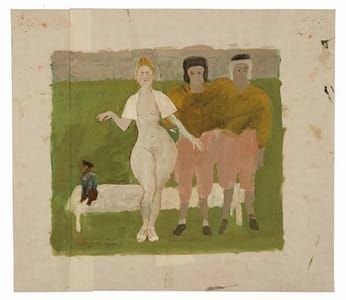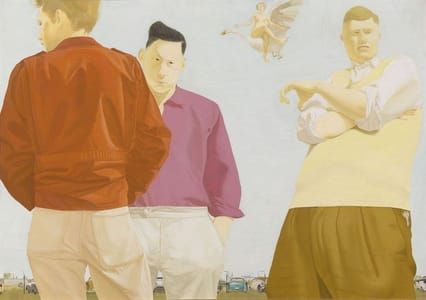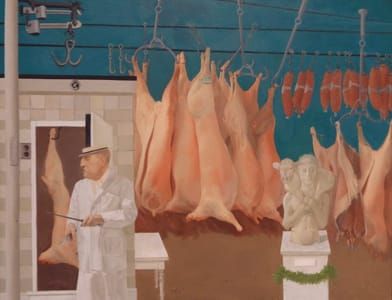
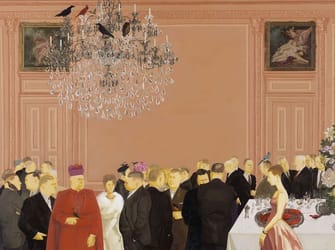
Reception, 1958
Honoré Sharrer
...or now I want to bring your attention to the corners of her painting Reception, 1958.
While the surreal interplay of society luminaries and birds takes place in the scene at the base of the painting, to the left and right corners we encounter two reproduced 18th century paintings. On the right is François Boucher’s Jupiter in the Guise of Diana, and the Nymph Callisto by and on the left, partially covered by the chandelier and its accompanying birds resembles (but may not be exactly) Apollo and Daphne by Giovanni Battista Tiepolo. (While I cannot be sure of this latter identification, the position of the arms make the Daphne myth definitely possible).
Elsewhere in her work, Sharrer more directly intervenes in the themes of ancient gods’ deceptive rapes, abductions and sexual conquests of mortal women and nymphs, especially in her work devoted to the Leda myth.
et in Reception, the positioning of the two myths in their 18th century renditions in the upper corners of the canvas may offer a nuance and critical reference to Ovid’s Metamorphoses. While many of these tales appear in the early books of Ovid’s poem, in Book 6 we see the different gods and their rapes within a critical context of Arachne’s tapestry Arachne’s work is directly reacting to Athena/Minerva’s grandiose portrait of herself and the other Olympians by showing the male gods as sexual predators. In Minerva’s tapestry, the corners depict the punishment of moral women who challenge the authority of goddesses, especially Juno. Arachne’s catalogue approach to listing the divine rapes disturbs this neat (‘classical’) order. Could Sharrer’s Reception be transforming Minerva’s corners into those of Arachne through the myths of Daphne and Callisto? If so it add another nuance not only to Sharrer’s feminist appropriation of Classical myth, but also to the male scholarly sheepishness in actually labeling these violent episodes in Ovid’s poems as rapes (carried out or attempted).
...With Sharrer’s Reception we find an artist who extends her critique of patriarchal social hierarchies, their pomp and pretension, to the casual display of rape scenes from Classical myth. Like Arachne herself, Sharrer allows us to engage with critical readings of this repeated sexual violence in direct and explicit ways.
[http://minusplato.com/2017/02/the-rape-corners-honore-sharrer-as-arachne.html]
“Reception” features François Boucher’s “Jupiter in the Guise of Diana, and the Nymph Callisto” and a second, more obscured image, both of which show mythical rape scenes as they hang high on salmon-colored walls above a lavish gathering. The work represents Sharrer’s transition from celebrating the life of the common worker to exposing the abuses of the rich and politically powerful. Those milling around the reception include US Senator Joseph McCarthy — whose political machinations were directly responsible for Sharrer’s exile — FBI Director J. Edgar Hoover, and Cardinal Francis Spellman. Opposite Spellman is the only other figure in colorful attire, who’s also located on the same foreground plane as him: a young woman in a pink ball gown with a reflective attitude. Separated from the rest of the reception by a banquet table, this figure seems to be a likely stand-in for the artist, who at that point in her career was already experiencing the alienation to which most confrontational women can relate.
The eye is drawn around “Reception” by the rich details of the partygoers below, an ornate crystal chandelier above, and the surreal presence of live birds roosting atop the lighting fixture and on people’s heads. But the entire middle of the painting consists of the empty space of the background wall. There is a real oddity to Sharrer’s compositions — the horizon is often pushed awkwardly high or low, defying the rule of thirds at every turn. Her knack for extraordinary detail and inclusion of eye-catching and surreal elements force the viewer’s gaze to move everywhere — there are no simple pathways through her work. Sharrer draws the viewer into a complicated visual conversation; perhaps it is projection to note that complexity is another quality rarely championed in women. There’s nowhere for the eye to rest in her paintings; they require exceptionally active viewing and, like most “difficult” women, refuse to let the viewer off easily.
[https://hyperallergic.com/371227/discovering-honore-sharrer-an-eclipsed-20th-century-surrealist-painter/]
Uploaded on Dec 15, 2017 by Suzan Hamer
Honoré Sharrer
artistArthur
Wait what?


